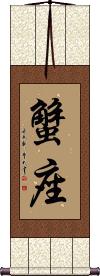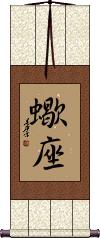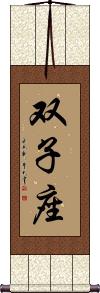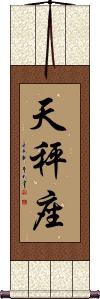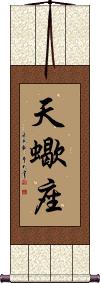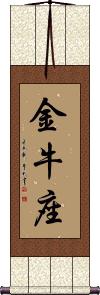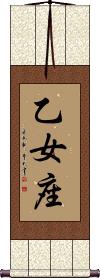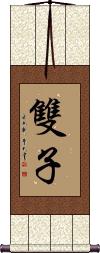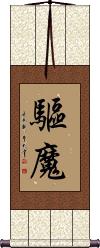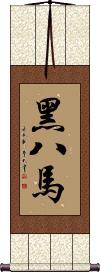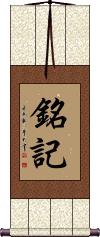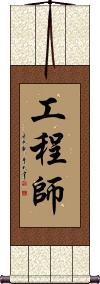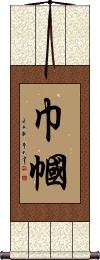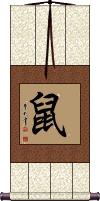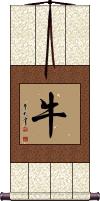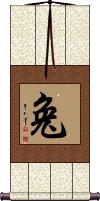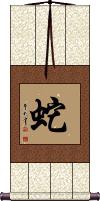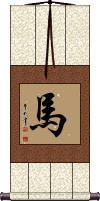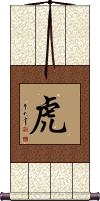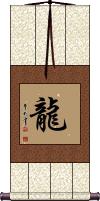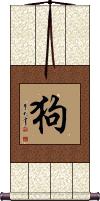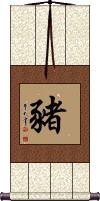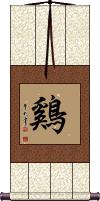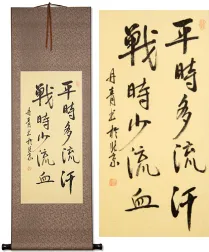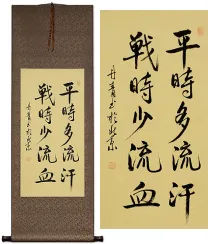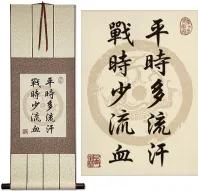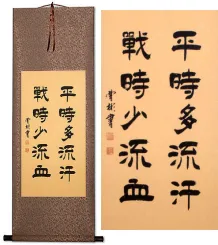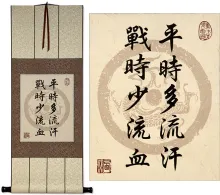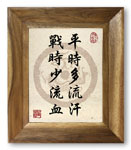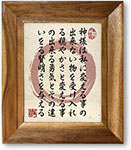Many custom options...
And formats...

Sign In in Chinese / Japanese...
Buy a Sign In calligraphy wall scroll here!
Personalize your custom “Sign In” project by clicking the button next to your favorite “Sign In” title below...
See also: Chinese Zodiac / Animal Years
1. Cancer
2. Pisces
3. Scorpio
4. Aquarius
5. Aries
6. Cancer
7. Capricorn
8. Gemini
9. Leo
10. Libra
11. Ophiuchus
12. Pisces
13. Sagittarius
14. Scorpio
15. Taurus
16. Virgo
17. Conquering Yourself is a Sign of Strength
18. Gemini
19. Repel Evil / Expel the Devil
20. Presence of Mind
22. Homosexual / Gay
24. Osu No Seishin
25. Homosexual / Gay
27. Remember
28. Accountant / CPA
29. Naruto
30. Engineer
31. Beauty Shop / Beauty Salon
32. Woman
33. Phenomenon
34. Double Happiness Guest Book
35. Rat / Mouse
36. Ox / Bull / Cow
37. Rabbit / Hare
38. Snake / Serpent
39. Horse
40. Goat / Sheep
41. Monkey
42. Tiger
43. Dragon
44. Dog
45. Boar / Pig
Cancer Zodiac Symbol / Sign
蟹座 is the Japanese way to write Cancer (crab) of western astrology.
Please note this version is only used in Japanese (see the other version if Chinese is your audience).
See Also: Chinese Zodiac
Pisces Zodiac Symbol / Sign
魚座 is the Japanese way to write Pisces (fish) of western astrology.
Please note this version is only used in Japanese (see the other version if Chinese is your audience).
See Also: Chinese Zodiac
Scorpio Zodiac Symbol / Sign
蠍座 is the Japanese way to write Scorpio (scorpion) of western astrology.
Please note this version is only used in Japanese (see the other version if Chinese is your audience).
See Also: Chinese Zodiac
Aquarius Zodiac Symbol / Sign
水瓶座 is the Chinese and Japanese way to write Aquarius (water bearer) of western astrology.
See Also: Chinese Zodiac
Aries Zodiac Symbol / Sign
牡羊座 is the Chinese and Japanese way to write Aries (ram) of western astrology.
See Also: Chinese Zodiac
Aries Zodiac Symbol / Sign
(Alternate / Chinese)
白羊座 is an alternate Chinese way to write Aries (ram) from western astrology.
I don't believe it is used at all in Japanese, so the other version is probably better or at least more universal.
See Also: Chinese Zodiac
Cancer Zodiac Symbol / Sign
巨蟹座 is the Chinese way to write Cancer (crab) from western astrology.
Please note this version is only used in Chinese (see the other version if Japanese is your audience).
See Also: Chinese Zodiac
Capricorn Zodiac Symbol / Sign
山羊座 is the Chinese and Japanese way to write Capricorn (horned goat) from western astrology.
See Also: Chinese Zodiac
Capricorn Zodiac Symbol / Sign
(Alternate / Chinese)
摩羯座 is an alternate Chinese way to write Capricorn (horned goat) from western astrology.
I don't believe it is used at all in Japanese, so the other version is probably better or at least more universal.
See Also: Chinese Zodiac
Gemini Zodiac Symbol / Sign
雙子座 is the Chinese way to write Gemini (twins) of western astrology.
This was also the version used in Japan until they simplified the first Kanji to 双 after WWII. If you need the modern Japanese 双子座 instead of the older 雙子座, just let me know when you place your order.
See Also: Chinese Zodiac
Gemini Zodiac Symbol / Sign
雙子座 is the Japanese way to write Gemini (twins) from western astrology.
This also happens to be the Simplified Chinese version of this title - however, I recommend the Traditional Chinese version if your audience is Chinese.
See Also: Chinese Zodiac
Leo Zodiac Symbol / Sign
獅子座 is the Chinese and Japanese way to write Leo (lion) of western astrology.
See Also: Chinese Zodiac
Libra Zodiac Symbol / Sign
天秤座 is the Chinese and Japanese way to write Libra (scales) of western astrology.
See Also: Chinese Zodiac
Ophiuchus Zodiac Symbol / Sign
蛇夫座 is the Chinese way to write Ophiuchus (the serpent bearer) of western astrology.
Please note this version is only used in Chinese (not Japanese).
See Also: Chinese Zodiac
Pisces Zodiac Symbol / Sign
雙魚座 is the Chinese way to write Pisces (fish) from western astrology.
Please note this version is only used in Chinese (see the other version if Japanese is your audience).
See Also: Chinese Zodiac
Sagittarius Zodiac Symbol / Sign
射手座 is the Chinese and Japanese way to write Sagittarius (archer) of western astrology.
See Also: Chinese Zodiac
Scorpio Zodiac Symbol / Sign
天蠍座 is the Chinese way to write Scorpio (scorpion) from western astrology.
Please note this version is only used in Chinese (see the other version if Japanese is your audience).
See Also: Chinese Zodiac
Taurus Zodiac Symbol / Sign
金牛座 is the Chinese way to write Taurus (bull) from western astrology.
Please note this version is only used in Chinese (see the other version if Japanese is your audience).
See Also: Chinese Zodiac
Taurus Zodiac Symbol / Sign
牡牛座 is the Japanese way to write Taurus (bull) from western astrology.
Please note this version is only used in Japanese (see the other version if Chinese is your audience).
See Also: Chinese Zodiac
Virgo Zodiac Symbol / Sign
處女座 is the Chinese way to write Virgo (virgin) from western astrology.
Please note this version is only used in Chinese (see the other version if Japanese is your audience).
See Also: Chinese Zodiac
Virgo Zodiac Symbol / Sign
乙女座 is the Japanese way to write Virgo (virgin) from western astrology.
Please note this version is only used in Japanese (see the other version if Chinese is your audience).
See Also: Chinese Zodiac
Conquering Yourself is a Sign of Strength
Gemini
Repel Evil / Expel the Devil
驅魔 is the way you would write a sign or symbol to repel the devil or drive away evil in Chinese.
Presence of Mind
Eight Black Horses
Homosexual / Gay
Therapeutic Massage
推拿 is “Tui Na,” a Chinese version of therapeutic massage.
The title suggests a pushing and pulling motion.
In reality, this is the most legitimate form of massage in China. Seeing this on a sign in front of a building tells you it's a place for health improvement via massage. No mistaking this for any illicit version of massage.
Osu No Seishin
押忍の精神 is the name Osu No Seishin or “Spirit of Osu” in Japanese.
This Spirit of Osu is an essential concept in Karate. You will hear “Osu!” shouted in every Karate dojo which is not just a sign of respect and obedience to the Sensei but also means patience, determination, and perseverance. Shouting “Osu!” serves as a reminder to embody these qualities.
Homosexual / Gay
同性愛 is a great way to tell your Japanese friends about your lifestyle while keeping your Anglo friends in the dark.
Kind of a huge bold sign to say “I'm Gay” without anybody knowing.
These Kanji characters literally mean “same-sex love.” This phrase would also be understood in Chinese but this combination would act to really emphasize the “love” component to a native Chinese person.
1 Corinthians 14:22
Here is 1 Corinthians 14:22 in Chinese.
The text with punctuation:
这样看来,说方言,不是为信的人作证据,乃是为不信的人。作先知讲道,不是为不信的人作证据,乃是为信的人。
Hand-painted calligraphy does not retain punctuation.
This translation is from the Chinese Union Bible.
You may know it from the KJV as:
Wherefore tongues are for a sign, not to them that believe, but to them that believe not: but prophesying serveth not for them that believe not, but for them which believe.
Remember
銘記 means to keep in mind, to take note of, or simply to remember, in Chinese characters and Japanese Kanji.
The first character means to engrave, inscribe, or carve an inscription.
The second character means to remember, note, mark, sign, record, history, chronicle, or annals.
When used in the context of a person, this means to engrave on the heart or to inscribe a memory in one's mind. In short, it's the idea of deeply remembering something, some event, or someone forever.
Accountant / CPA
會計師 is the occupational or legal title of an accountant in Chinese and Korean.
In Asia, particular studies and certifications are needed to obtain this title. Therefore, this is the closest match to the English term for Certified Public Accountant. Such a professional might have a sign on his desk or a name badge that has his/her name on it and this title in Chinese characters. It's not too common to see this on a wall scroll in Asia, but you can take such liberties in the west.
Naruto
Japanese Anime Series
ナルト is the title “Naruto” from the Japanese animation series. See Naruto Anime Series.
Because of the unique Japanese character set used to write this title, it can only be written by the Japanese master calligrapher. Do not try to order it from one of my Chinese calligraphers.
Please note that while this is the correct title for this anime series, it can also mean the “@” sign or “at” in Japanese under a different context (a Japanese person not familiar with the series may be confused by your wall scroll).
Note: Because this title is entirely Japanese Katakana, it should be written by a Japanese calligrapher.
Engineer
工程師 is the occupational title of an engineer in Chinese.
In China, an engineer might have a sign on his desk or a name badge with his/her name on it and this title. It's not too common to see this on a wall scroll in China, but you are allowed to take such liberties in the west.
Note that in China, a wall scroll like this is sometimes given to a teacher who builds (engineers) the spirits of their students. It's a way to honor a teacher, and in this case, the meaning departs from an occupational title.
Beauty Shop / Beauty Salon
美容店 is how to write “Beauty Shop” or “Beauty Salon.”
If you own such a business, this will make a nice wall scroll to hang up - and many of your Asian customers will be able to read and appreciate it.
When traveling in China, you will see signs like this in the window of any place that offers full services of hair styling, manicures, pedicures, and often shampoo with head and back massage.
However, as a handmade wall scroll, this becomes a very fancy piece of artwork that shows the high class of your business (a great sign for your window if you don't get direct sunlight).
Woman
The ancient way to say Woman
巾幗 is the very old way to say woman in Chinese.
A common title in ancient China, this actually refers to the scarf or head wrapping worn by virtually all women at that time.
巾幗 is kind of a cool way to say Woman now. The actual gender character alone on a wall scroll would actually look like a fancy sign for the woman's restroom (WC).
![]() If you are curious, the character to the right means female or woman. Knowing 女 is useful information if you are a woman searching for a toilet in China or Japan.
If you are curious, the character to the right means female or woman. Knowing 女 is useful information if you are a woman searching for a toilet in China or Japan.
Phenomenon
I must first say that 現象 is an odd thing to put on a wall scroll in Asian cultures. It won't make a lot of sense alone unless you have a special or personal meaning that you attach to it for yourself.
These two characters mean phenomenon in Chinese, Japanese, and Korean Hanja. They can also be translated as “a happening,” depending on context.
The sum of these characters is a little different than their individual meanings. But I will break it down anyway...
The first character means present, existing, actual, apparent, now, or current.
The second character alone means pattern after, imitate, image, shape, sign (of the times), form, appearance, to be like, to resemble, to take after, to seem, or elephant.
Double Happiness Guest Book
Customize a special Asian guest book for your wedding
Start customizing a “Double Happiness Guest Book Wall Scroll” Here!
The paper panel length can be whatever you choose from 68cm to 135cm (27” to 53”).
If you don't mention what paper length you want in the special instructions tab (on the next page), we'll make it about 100cm (40”).

The medium-size scroll with a 33cm x 100cm (13” x 40”) paper panel can usually handle up to 89 signatures. That breaks down to 37 signatures per empty square and 15 signatures around the 囍 character. If you switch to a 135cm paper panel, add another 37 potential signatures.
We can splice two 135cm papers together, but that would be a crazy-long scroll. These are only estimates, your mileage may vary.
With silk panels, this will yield a wall scroll about 155cm (61”) long. That's enough for up to 89 signatures. Of course, that depends on if your guests just sign a brief salutation and name, or more verbose good wishes. Customer feedback is that 126 people can sign the 135cm long paper on a medium-sized scroll. If we go bigger than that, there will be a minor paper seam and an extra charge. Email me with your specifications if you need something special.
Most customers pick the festive red paper with gold flecks and white or ivory silk. Red is a good luck color in Chinese culture, thus the most popular choice. But, you can do any color combination that you want.
There is a long history of Chinese-character-use outside of mainland China. This Double Happiness character is also seen at weddings in Korea, Vietnam, Hong Kong, and Taiwan, as well as in Chinese communities in Thailand, Indonesia, and elsewhere. While Japan borrowed Chinese characters into their language, you won't see 囍 as often at Japanese weddings.
Rat / Mouse
Year of the Rat / Zodiac Sign
鼠 is the character for rat (and sometimes mouse) in Chinese, old Korean, and Japanese.
If you were born in the year of the Rat, you . . .
Are sensitive and smart.
Easily adapting to new environments.
Have a curious nature.
Are good at using the opportunities that are presented to you.
In some contexts, this character could mean “mouse.”
See also our Chinese Zodiac page.
Ox / Bull / Cow
Year of the Ox / Bull - Zodiac Sign
牛 is the character for bull, cow, ox, or bovine creature in Chinese, old Korean, and Japanese.
If you were born in the year of the ox/bull/cow, you . . .
Are dedicated to your work.
Are discrete, careful and conscientious.
Value work and family.
Note that in this Chinese character, there is no distinction between bull and cow. All bovine creatures fit into the definition of this character. To distinguish between male and female, another sex-designating character is added in front of this character. Therefore, in China, the energy drink “Red Bull” (Hong Niu) is often translated in the minds of Chinese people as “Red Cow” or even “Red Ox.”
See also our Chinese Zodiac page.
Rabbit / Hare
Year of the Rabbit / Zodiac Sign
兔 is the character for rabbit or hare in Chinese, old Korean, and Japanese.
If you were born in the year of the rabbit, you...
Are gentle and full of sympathy.
Love to help others.
Enjoy a quiet life.
Are a good worker.
Are, however, a bit of a pushover.
See also our Chinese Zodiac page.
Snake / Serpent
Year of the Snake / Zodiac Sign
蛇 is the character for snake or serpent in Chinese, old Korean, and Japanese.
If you were born in the year of the snake, you . . .
Are calm.
Are an inspiration to others.
Have a stubborn nature like a mule (you do not like to concede).
See also our Chinese Zodiac page.
Horse
Year of the Horse / Zodiac Sign
馬 is the character for a horse in Chinese, old Korean, and Japanese.
If you were born in the year of the horse, you . . .
Are outgoing and active.
Don't give up easily.
Are known to have a bad temper.
See also our Chinese Zodiac page.
Goat / Sheep
Year of the Goat / Zodiac Sign
羊 is the character for goat or sheep in Chinese, old Korean, and Japanese.
If you were born in the year of the goat (sheep), you . . .
Are sophisticated and considerate
Can always find the best solution to problems.
Are tolerant.
Are not afraid of hardship.
Know how to save money (thrifty).
See also our Chinese Zodiac page.
Monkey
Year of the Monkey / Zodiac Sign
猴 is the monkey character in Chinese.
猴 means ape in Japanese due to an error made long ago as Japan absorbed Chinese characters.
If you were born in the year of the monkey, you . . .
Are smart, brave, active, and competitive.
Like new things.
Have a good memory.
Are quick to respond
Have an easy time winning people's trust.
Are, however, not very patient.
See also our Chinese Zodiac page.
Note: This character does have the meaning of monkey in Korean Hanja but is not used very often.
Tiger
Year of the Tiger / Zodiac Sign
虎 is the character for tiger in Chinese, old Korean Hanja, and Japanese Kanji.
Since you already know what a tiger is, here's some trivia: If you look at the Japanese pronunciation, you might remember a movie called “Tora Tora Tora” which was the code word used to initiate the attack on Pearl Harbor. It simply means “Tiger Tiger Tiger.”
In Chinese culture, the tiger is considered to be the king of all animals (in much the way we see the lion in western culture).
From the Chinese Zodiac, if you were born in the year of the tiger, you . . .
Have a strong personality.
Are full of self-confidence.
Love adventure
Don't like to obey others.
See also our Chinese Zodiac or Tiger Calligraphy pages.
Dragon
Year of the Dragon / Zodiac Sign
龍 is the character for dragon in Chinese, old Korean Hanja, and Japanese Kanji.
The dragon is a creature of myth and legend that dominates Chinese, Japanese, and even European folklore. In China, the dragon is the symbol of the Emperor, strength, and power, and the Chinese dragon is known as the god of water.
From the Chinese Zodiac, if you were born in the year of the Dragon, you . . .
Have a strong body and spirit.
Are full of energy.
Have vast goals.
Have a deep level of self-awareness.
Will do whatever you can to “save face.”
See also our Chinese Zodiac or Dragon Calligraphy pages.
Dog
Year of the Dog / Zodiac Sign
狗 is the character for dog, canine, or hound in Chinese.
If you were born in the year of the dog, you . . .
Are strong-willed
Loyal to your friends and mate.
Never compromise when you think you are right.
Note: Can be pronounced, and means dog in Japanese but feels like a very old word (see our other dog if you need a Japanese dog).
See also our Chinese Zodiac page.
Boar / Pig
Year of the Pig / Zodiac Sign
豬 is the character for boar, pig, or swine in Chinese and old Korean.
If you were born in the year of the boar/year of the pig, you...
Are optimistic.
Have good luck with wealth and money.
Are honest, generous, and warm-hearted.
![]() The character shown to the right is the Japanese Kanji for "wild boar."
The character shown to the right is the Japanese Kanji for "wild boar."
it’s
an alternate/simplified form of pig/boar in Chinese (can be read by both Chinese and Japanese people). Click on that character instead of the button above if you want this version.
See also our Chinese Zodiac page.
Rooster / Chicken
Year of the Rooster / Zodiac Sign
鷄 or 雞 is the character for rooster or chicken in Chinese, old Korean, and Japanese.
If you were born in the year of the rooster (chicken), you . . .
Have a unique sense of color.
Are highly principled and responsible.
Have persuasive power.
Are honest.
Have a great ability to communicate.
Please note: There are a few different ways to write rooster/chicken, as shown to the right. If you are particular about the form, please let us know when you place your order.
See also our Chinese Zodiac page.
This in-stock artwork might be what you are looking for, and ships right away...
Gallery Price: $120.00
Your Price: $61.88
Gallery Price: $120.00
Your Price: $61.88
Gallery Price: $90.00
Your Price: $49.88
Gallery Price: $220.00
Your Price: $112.88
Gallery Price: $60.00
Your Price: $36.88
Gallery Price: $220.00
Your Price: $99.88
Gallery Price: $106.00
Your Price: $58.88
Starting at: $19.88
Gallery Price: $61.00
Your Price: $33.88
The following table may be helpful for those studying Chinese or Japanese...
| Title | Characters | Romaji (Romanized Japanese) | Various forms of Romanized Chinese | |
| Cancer Zodiac Symbol Sign | 蟹座 | kani-za | xiè zuò / xie4 zuo4 / xie zuo / xiezuo | hsieh tso / hsiehtso |
| Pisces Zodiac Symbol Sign | 魚座 鱼座 | uo-za | yú zuò / yu2 zuo4 / yu zuo / yuzuo | yü tso / yütso |
| Scorpio Zodiac Symbol Sign | 蠍座 蝎座 | sasori-za | ||
| Aquarius Zodiac Symbol Sign | 水瓶座 | mizugame-za | shuǐ píng zuò shui3 ping2 zuo4 shui ping zuo shuipingzuo | shui p`ing tso shuipingtso shui ping tso |
| Aries Zodiac Symbol Sign | 牡羊座 | ohitsuji-za | mù yáng zuò mu4 yang2 zuo4 mu yang zuo muyangzuo | mu yang tso muyangtso |
| Aries Zodiac Symbol Sign | 白羊座 | bái yáng zuò bai2 yang2 zuo4 bai yang zuo baiyangzuo | pai yang tso paiyangtso |
|
| Cancer Zodiac Symbol Sign | 巨蟹座 | jù xiè zuò ju4 xie4 zuo4 ju xie zuo juxiezuo | chü hsieh tso chühsiehtso |
|
| Capricorn Zodiac Symbol Sign | 山羊座 | yagi-za | shān yáng zuò shan1 yang2 zuo4 shan yang zuo shanyangzuo | shan yang tso shanyangtso |
| Capricorn Zodiac Symbol Sign | 摩羯座 | mó jié zuò mo2 jie2 zuo4 mo jie zuo mojiezuo | mo chieh tso mochiehtso |
|
| Gemini Zodiac Symbol Sign | 雙子座 双子座 | futago-za | shuāng zǐ zuò shuang1 zi3 zuo4 shuang zi zuo shuangzizuo | shuang tzu tso shuangtzutso |
| Gemini Zodiac Symbol Sign | 雙子座 双子座 | futago-za | shuāng zǐ zuò shuang1 zi3 zuo4 shuang zi zuo shuangzizuo | shuang tzu tso shuangtzutso |
| Leo Zodiac Symbol Sign | 獅子座 狮子座 | shishi-za | shī zǐ zuò shi1 zi3 zuo4 shi zi zuo shizizuo | shih tzu tso shihtzutso |
| Libra Zodiac Symbol Sign | 天秤座 | tenbin-za | tiān chèng zuò tian1 cheng4 zuo4 tian cheng zuo tianchengzuo | t`ien ch`eng tso tienchengtso tien cheng tso |
| Ophiuchus Zodiac Symbol Sign | 蛇夫座 | shé fū zuò she2 fu1 zuo4 she fu zuo shefuzuo | she fu tso shefutso |
|
| Pisces Zodiac Symbol Sign | 雙魚座 双鱼座 | shuāng yú zuò shuang1 yu2 zuo4 shuang yu zuo shuangyuzuo | shuang yü tso shuangyütso |
|
| Sagittarius Zodiac Symbol Sign | 射手座 | ite-za | shè shǒu zuò she4 shou3 zuo4 she shou zuo sheshouzuo | she shou tso sheshoutso |
| Scorpio Zodiac Symbol Sign | 天蠍座 天蝎座 | tiān xiē zuò tian1 xie1 zuo4 tian xie zuo tianxiezuo | t`ien hsieh tso tienhsiehtso tien hsieh tso |
|
| Taurus Zodiac Symbol Sign | 金牛座 | jīn niú zuò jin1 niu2 zuo4 jin niu zuo jinniuzuo | chin niu tso chinniutso |
|
| Taurus Zodiac Symbol Sign | 牡牛座 | oushi-za / oshi-za | ||
| Virgo Zodiac Symbol Sign | 處女座 处女座 | chù nǚ zuò chu4 nv3 zuo4 chu nv zuo chunvzuo | ch`u nü tso chunütso chu nü tso |
|
| Virgo Zodiac Symbol Sign | 乙女座 | otome-za | yǐ nǚ zuò yi3 nv3 zuo4 yi nv zuo yinvzuo | i nü tso inütso |
| Conquering Yourself is a Sign of Strength | 自勝者強也 | zì shèng zhě qiáng yě zi4 sheng4 zhe3 qiang2 ye3 zi sheng zhe qiang ye zishengzheqiangye | tzu sheng che ch`iang yeh tzushengchechiangyeh tzu sheng che chiang yeh |
|
| Gemini | 雙子 双子 | shuāng zǐ shuang1 zi3 shuang zi shuangzi | shuang tzu shuangtzu |
|
| Repel Evil Expel the Devil | 驅魔 驱魔 | qū mó / qu1 mo2 / qu mo / qumo | ch`ü mo / chümo / chü mo | |
| Presence of Mind | 泰然自若 | taizenjijaku | tài rán zì ruò tai4 ran2 zi4 ruo4 tai ran zi ruo tairanziruo | t`ai jan tzu jo taijantzujo tai jan tzu jo |
| Eight Black Horses | 黑八馬 黑八马 | hēi bā mǎ hei1 ba1 ma3 hei ba ma heibama | hei pa ma heipama |
|
| Homosexual Gay | 同性戀 同性恋 | tóng xìng liàn tong2 xing4 lian4 tong xing lian tongxinglian | t`ung hsing lien tunghsinglien tung hsing lien |
|
| Therapeutic Massage | 推拿 | tuī ná / tui1 na2 / tui na / tuina | t`ui na / tuina / tui na | |
| Osu No Seishin | 押忍の精神 | o su no sei shin osunoseishin | ||
| Homosexual Gay | 同性愛 同性爱 | douseiai / doseiai | tóng xìng ài tong2 xing4 ai4 tong xing ai tongxingai | t`ung hsing ai tunghsingai tung hsing ai |
| 1 Corinthians 14:22 | 這樣看來說方言不是為信的人作証據乃是為不信的人作先知講道不是為不信的人作証據乃是為信的人 这样看来说方言不是为信的人作证据乃是为不信的人作先知讲道不是为不信的人作证据乃是为信的人 | zhè yàng kàn lái shuō fāng yán bù shì wéi xìn de rén zuò zhèng jù nǎi shì wéi bù xìn de rén zuò xiān zhī jiǎng dào bù shì wéi bù xìn de rén zuò zhèng jù nǎi shì wéi xìn de rén zhe4 yang4 kan4 lai2 shuo1 fang1 yan2 bu4 shi4 wei2 xin4 de ren2 zuo4 zheng4 ju4 nai3 shi4 wei2 bu4 xin4 de ren2 zuo4 xian1 zhi1 jiang3 dao4 bu4 shi4 wei2 bu4 xin4 de ren2 zuo4 zheng4 ju4 nai3 shi4 wei2 xin4 de ren2 zhe yang kan lai shuo fang yan bu shi wei xin de ren zuo zheng ju nai shi wei bu xin de ren zuo xian zhi jiang dao bu shi wei bu xin de ren zuo zheng ju nai shi wei xin de ren | che yang k`an lai shuo fang yen pu shih wei hsin te jen tso cheng chü nai shih wei pu hsin te jen tso hsien chih chiang tao pu shih wei pu hsin te jen tso cheng chü nai shih wei hsin te jen che yang kan lai shuo fang yen pu shih wei hsin te jen tso cheng chü nai shih wei pu hsin te jen tso hsien chih chiang tao pu shih wei pu hsin te jen tso cheng chü nai shih wei hsin te jen |
|
| Remember | 銘記 | mei ki / meiki | míng jì / ming2 ji4 / ming ji / mingji | ming chi / mingchi |
| Accountant CPA | 會計師 会计师 | kuài jì shī kuai4 ji4 shi1 kuai ji shi kuaijishi | k`uai chi shih kuaichishih kuai chi shih |
|
| Naruto | ナルト | na ru to / naruto | ||
| Engineer | 工程師 工程师 | gōng chéng shī gong1 cheng2 shi1 gong cheng shi gongchengshi | kung ch`eng shih kungchengshih kung cheng shih |
|
| Beauty Shop Beauty Salon | 美容店 | měi róng diàn mei3 rong2 dian4 mei rong dian meirongdian | mei jung tien meijungtien |
|
| Woman | 巾幗 巾帼 | jīn guó / jin1 guo2 / jin guo / jinguo | chin kuo / chinkuo | |
| Phenomenon | 現象 现象 | genshou / gensho | xiàn xiàng xian4 xiang4 xian xiang xianxiang | hsien hsiang hsienhsiang |
| Double Happiness Guest Book | 囍 喜喜 | xǐ / xi3 / xi | hsi | |
| Rat Mouse | 鼠 | nezumi | shǔ / shu3 / shu | |
| Ox Bull Cow | 牛 | ushi | niú / niu2 / niu | |
| Rabbit Hare | 兔 | usagi | tù / tu4 / tu | t`u / tu |
| Snake Serpent | 蛇 | hebi | shé / she2 / she | |
| Horse | 馬 马 | uma | mǎ / ma3 / ma | |
| Goat Sheep | 羊 | hitsuji | yáng / yang2 / yang | |
| Monkey | 猴 | hóu / hou2 / hou | ||
| Tiger | 虎 | tora | hǔ / hu3 / hu | |
| Dragon | 龍 龙 | ryuu / tatsu ryu / tatsu | lóng / long2 / long | lung |
| Dog | 狗 | inu / ku | gǒu / gou3 / gou | kou |
| Boar Pig | 豬 猪 | inoshishi | zhū / zhu1 / zhu | chu |
| Rooster Chicken | 鷄 or 雞 鸡 or 鶏 | niwatori | jī / ji1 / ji | chi |
| In some entries above you will see that characters have different versions above and below a line. In these cases, the characters above the line are Traditional Chinese, while the ones below are Simplified Chinese. | ||||
Successful Chinese Character and Japanese Kanji calligraphy searches within the last few hours...
